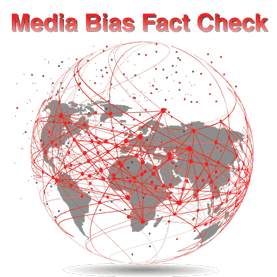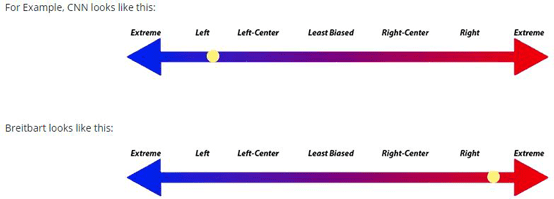

In a Nutshell: With so many sources of information on the internet, today’s media landscape can feel like a confusing and chaotic affair. At least a portion of American voters base their ballot choices on things they have learned from the news. And these choices not only help determine who holds office, but they can have a major impact on the economy and social issues. Media Bias/Fact Check, a resource where consumers can determine how biased a particular media outlet might be, helps to tame the chaos. The website maintains a level of consistency among its evaluations by employing a quantifiable scale and a standard methodology. And the site shows how news consumers can learn to be vigilant against overly biased or untrustworthy sources by following a few simple steps. With the increased awareness of media bias, there is hope that the current situation will improve over time.
Before the internet, before blogs, before CNN and the 24-hour news cycle, there were newspapers.
Americans generally kept up with the world around them by flipping through their daily paper, which tended to be a trusted source of information for local, national, and international news. Particularly attentive news consumers subscribed to several papers.
Consumers learned about the platforms of political candidates in part from newspapers, and voted based on issues that were important to them, including the economy and the size of government.
 When CNN launched as the world’s first 24-hour news channel in 1980, the world of news media changed forever with a constant flow of information.
When CNN launched as the world’s first 24-hour news channel in 1980, the world of news media changed forever with a constant flow of information.
Then came the internet with endless channels with which to ply consumers with news. Today, countless websites cover the spectrum, from secretly funded and fully deceptive websites pretending to report news, to news websites of varying degrees of bias, to legitimate and trustworthy news sources.
Oh, and social media.
Over the past couple of years, media outlets of all stripes have at times gained equal footing with various audiences, making for a confusing, frustrating, and sometimes disheartening experience for consumers.
Some of this confusion has led to real-world consequences for some Americans. Many Midwest farmers voted for Donald Trump based on the promise of economic policies that would benefit them. And some less trustworthy websites amplified those promises and at times distorted them to unrealistic proportions, all the while presenting it as real news.
But based on Trump’s recent tariffs, experts are predicting that farmers are going to be taking the economic brunt of the President’s policy.
These kinds of situations also lead to cries of “fake news” from all sides. And for many, it really can be difficult to tell what’s real and what’s fake. Or what “fake news” even means.
“The term fake news has been extremely damaging to the media because the current meaning of that word is ‘something you don’t agree with,’” said Dave Van Zandt, founder of Media Bias/Fact Check. “It no longer means flat out false information. This is why highly credible, long-standing institutions are being labeled fake news by some on the right.”
He said while publications like The Washington Post or The New York Times may have a left-leaning editorial bias, they absolutely are not fake in any way.
As its name suggests, Media Bias/Fact Check serves as a robust resource for identifying media bias on the internet. Users can simply enter the name of a website or a specific URL to see results on how biased the source of information is determined to be.
Media Bias/Fact Check Offers Users a Safe Haven in an Increasingly Tumultuous Digital World
“Media Bias/Fact Check was an unplanned surprise,” Van Zandt said. “My main purpose for the website was to serve as a personal blog to write about media bias and to write up fact checks that Snopes and Politifact did not cover. That was it.”
The first iteration of the website simply displayed 100 sources with links in columns on the front page, he said. His intention for the website did not extend beyond just having an outlet where he could write about a topic that he is interested in.
“By mid-2016, as the presidential election was heating up, so was the traffic to the website,” Van Zandt said. “It was then that we created our current format with the rating bars and supporting evidence for ratings. It turns out there is a high interest in media bias and the website quickly became very popular.”

Dave Van Zandt said the term “fake news” has been detrimental to the media in recent years.
Politicians’ promises about economic policies to help the working class or bringing jobs back to the US swirled around the internet. Some sites reported the information accurately but plenty of others twisted messages to suit their own agendas.
Van Zandt said he often wonders where he would be if not for the polarizing election of 2016.
Media Bias/Fact Check is “dedicated to educating the public on media bias and deceptive news practices.” The website currently lists more than 2,500 media sources in its database, with the list growing every day.
The media sources are classified into one of several categories along a bias scale: Left Bias, Left-Center Bias, Least Biased, Right-Center Bias, and Right Bias. The site also presents sources classified into Pro-Science, Conspiracy-Pseudoscience, Questionable Sources, and Satire categories. It also includes a new section for re-evaluated sources.
Ironically, Van Zandt said the website has received its fair share of hate mail accusing it of media bias toward all parts of the political spectrum. But he has also heard from many users who were shocked to discover that they were only consuming information from one political spectrum and they said Media Bias/Fact Check help them expand to include a variety of sources.
“I had one person contact me to say that he was embarrassed that many of the sources he read were conspiracy websites and that he was going to try to filter his news to those on our least-biased list,” Van Zandt said.
Meticulous Research and a Standardized Methodology Ensures Consistent and Useful Results
The process of keeping up Media Bias/Fact Check is a time-consuming affair, Van Zandt said.
“The website has evolved from a few pages with columns of sources to now over 2,500 individual researched pages,” he said. “The website was not planned to be this way. It just evolved and because of that there was never a real template for source pages to make the work easier.”
Van Zandt has adjusted and learned how to make Media Bias/Fact Check work on the fly.
He said everything that goes into the site is a product of 100% manual human effort. And he acknowledges that, like all humans, each person on the team has his or her own biases, including left, right, and libertarian.
“Our methodology helps reduce individual bias because we are all looking for the same things, following the same guidelines and quantifying it on an identified scale,” he said.
According to the website’s methodology page, “When calculating bias we are not just looking at political bias, but also how factual the information is and if they provide links to credible, verifiable sources.”
Some factors that go into determining the bias level include biased wording and headlines, factual reporting, story choices, and political affiliation.
Each page displays a scale with a yellow dot indicating where a particular source falls along the spectrum. The website also includes a voting poll on each page so readers can vote their opinion on the bias of the source. Users can then see how Media Bias/Fact Check rates a source, and how the public rates it, similar to how movies are evaluated on sites like IMDB or Rotten Tomatoes.

Media Bias/Fact Check’s bias scale helps to identify sources that skew left or right.
If there is a large discrepancy between Media Bias/Fact Check’s evaluation and the public poll, the website will re-evaluate the source and adjust accordingly, if necessary.
Readers can find a full rundown of Media Bias/Fact Check’s methodology on its website.
Americans Can Take Steps on Their Own to Become Vigilant News Consumers
With friends sharing articles on social media and email, endless newsfeeds, and articles that pop up in general searches, things move fast these days. Oftentimes, readers may only read a headline and the first few lines of an article and move on.
While Media Bias/Fact Check remains popular and growing, the fact is many news consumers are still not going to take the time to go to yet another website to do a search about a headline they read.
Van Zandt said there are certain things news consumers can be aware of to help identify biased or untrustworthy sites on their own.

Consumers can take steps to ensure the trustworthiness of websites they view.
“The first place to look is at the domain name,” he said. “Does it seem strange or unrelated to the content? Does it end in .info, .us or something other than .com, .org., .gov, or .edu?”
Next, he said to look at the headlines to see if they are sensationalized, using a lot of adjectives to grab attention. Although a sensationalized headline does not necessarily mean the information is false, it almost always implies bias, he said.
Readers can also check to see if the source makes an about page available that describes its mission, who is involved, and who the owner of the website is. He said most fake or highly biased websites will not disclose this information.
“Lastly, if something just doesn’t seem right then simply Google it,” he said. “Look to see if other major media outlets are reporting the same information and see if any fact checkers have checked it. Just pasting the headline into Google can give great information at a glance without even clicking links.”
Increasing Awareness of Media Bias Indicates Hope for the Future of News
While it can feel chaotic to navigate through the headlines from day to day, Van Zandt said it is not all doom and gloom.
“I do have hope that things will improve though,” he said. “For example, Media Bias/Fact Check is being used in hundreds of high schools and colleges around the United States to teach about media bias.”
MIT is also in the process of developing an artificial intelligence platform that uses the Media Bias/Fact Check database to train computers to detect bias, Van Zandt said. And he is planning on redesigning the website in 2019, to make it more visually appealing.
“Overall, fake news will not win in the end, but it will never fully go away either,” Van Zandt said. “It must always remain, ‘Reader Beware!’, but, readers will have more resources at their disposal moving forward.”
Advertiser Disclosure
BadCredit.org is a free online resource that offers valuable content and comparison services to users. To keep this resource 100% free for users, we receive advertising compensation from the financial products listed on this page. Along with key review factors, this compensation may impact how and where products appear on the page (including, for example, the order in which they appear). BadCredit.org does not include listings for all financial products.
Our Editorial Review Policy
Our site is committed to publishing independent, accurate content guided by strict editorial guidelines. Before articles and reviews are published on our site, they undergo a thorough review process performed by a team of independent editors and subject-matter experts to ensure the content’s accuracy, timeliness, and impartiality. Our editorial team is separate and independent of our site’s advertisers, and the opinions they express on our site are their own. To read more about our team members and their editorial backgrounds, please visit our site’s About page.
